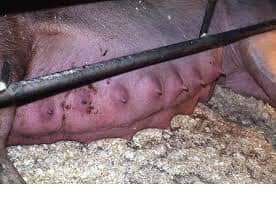Mastitis, Metritis, Agalactia (MMA)
By- Dr Parvinder kaur Lubana, Punjab.
Occurrence: Worldwide.
Age affected: Gilts, sows after farrowing.
Causes: Mismanagement; infections.
Effects: Within 48 hrs of farrowing – inappetence, hungry piglets, fever,
Causes
Generally caused by bacterial invasion of the udder and subsequent production of endotoxins (the cell wall lipopolysaccharide produced by bacteria like E. coli). Endotoxin cannot, however, always be demonstrated in the plasma of affected animals, neither can bacteria or mastitis always be identified in the mammary glands. Bacteria in the gut or in endometritis (uterine infection) may be the source of endotoxin in these cases. Hormonal causes have also been suggested. Levels of a number of hormones may be depressed following parturition. These represent the effector mechanism, but the initiating factors have not been identified. Hormones involved in lactation include insulin, cortisone and prolactin, oxytocin, oestrogen and progesterone and changes in their levels have been demonstrated in pigs with agalactia. Levels of oxytocin are often half those in normal sows. Prolactin levels may be dramatically reduced by small volumes of endotoxin and the inhibition of prostaglandin F2 alpha production in the uterus (possibly by infection) may reduce prolactin secretion. Management and nutrition appear to be important in the aetiology and little exercise, high nutrition density rations, overfeeding and poor hygiene all appear to predispose to the condition. The importance of genetics, water intake and stress or disturbance during parturition is not yet clear.
Mode of transmission
The condition is not transmissible directly from sow to sow, but occurs in successive groups of sows exposed to the same predisposing factors.
Clinical signs
The syndrome usually occurs within 12 hours – three days of parturition. Inappetence is commonly the first sign to be noted followed by depression, restlessness when being suckled and loss of condition in the litter. Affected sows may have a slight fever, 39.5-41°C if mastitis is present. In many cases, only a single gland is mastitic. Vulval discharge and constipation are frequently associated with this condition but neither may be present. The disease lasts for a minimum of 3 days and then resolves spontaneously. By this time the litter may have been lost. The condition may be preceded by delays in parturition (>5 hours) and may vary in its intensity. In mild cases of hypogalactia unaccompanied by mastitis or other elements of the complex, depressed daily live weight gain in piglets (<105 g/day, normal 125 g/day) may be the only indication of the problem.
Diagnosis is based on clinical signs, particularly inappetence in the sow and a reduction of condition in the litter. The udder should be palpated (felt) on both sides by running the hand under both lines of glands. Individual affected glands feel firm and hot. The presence of bacterial mastitis may be confirmed by the examination of milk samples. Collection requires oxytocin injection as milk let down is under voluntary control. The litter should be examined as diarrhoea, septicaemia or hypothermia may lead to decreased intake of milk and overstocking of the udder. Fever may indicate the presence of another disease (e.g. erysipelas). A history of difficulty in farrowing, small litters or incomplete cleansing, may indicate retention of a foetus or placentae. Examination per vagina, if within 24 hours of parturition, or later ultrasound examination, will establish this. In some cases mycotoxins such as trichoethecenes may be involved.
Postmortem lesions
Pathological investigation is of little value and is rarely performed for diagnostic reasons. Neither mastitis nor metritis is a constant finding. Where mastitis occurs, it appears to be patchy within a gland. Oedema of the subcutaneous tissue and inflammatory changes in the draining lymph nodes occur where mastitis is present. The microscopic structure of glands of affected pigs often resembles that of sows at 110 days’ gestation.
Treatment and prevention
Affected sows can be given frequent small doses of oxytocin, but this is not necessary if they are being suckled regularly. Antimicrobial infections are advisable when mastitis, metritis or fever are present. Ampicillin, tetracyclines, trimethoprim sulphonamide or enrofloxacin may be given. Anti-inflammatory drugs such as flunixin meglumine or corticosteroid may improve recovery. Piglets should receive sow colostrum by stomach tube or by sucking another sow, or be left with their mother and fed artificially until the sow recovers. The use of oxytocin in early cases may reduce the need for veterinary involvement. Treatment should begin when sow body temperature is 39.4°C, 12-18 hours post farrowing. Feed medication with trimethoprim: sulphonamide at 15 mg/kg body weight or tetracyclines from day 112 of gestation to day 1 post partum, reduces the incidence of the disease markedly if allowed. Long acting tetracycline injections given 1 day before farrowing may be beneficial. Practices which appear to reduce the incidence or severity of the condition include: farrowing early as a result of prostaglandin use; hygiene; exercise of the sows prior to farrowing and during the early stage of lactation; reduction of feed intake to 1 kg/day from 100 days’ gestation and use of vegetable protein. Adequate water should be available to sows at all times.


